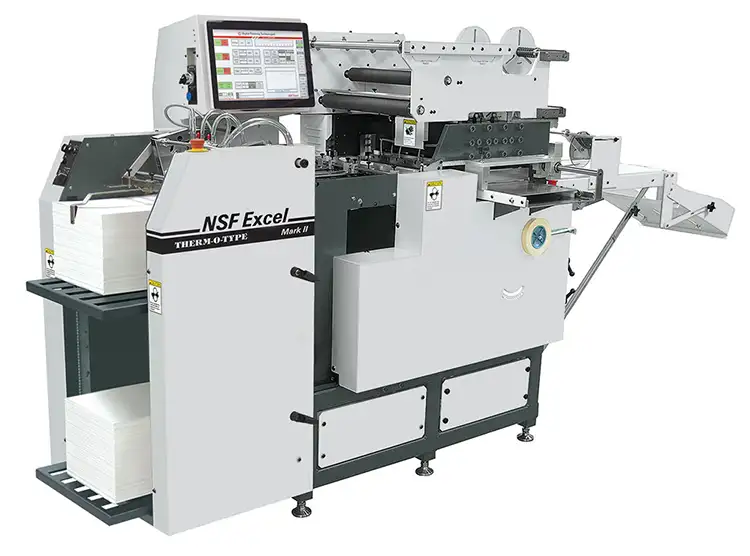
Edited by Erin La Row, editor, PostPress
Requirements for foil stamping, embossing and diecutting equipment using metal dies have changed over the past few years. Productivity, automation, ergonomics and safety issues are compelling many plants to replace outdated equipment.
The NSF Excel Mark II, offered by THERM-O-TYPE, located in Nokomis, Florida, has been specifically designed to meet the latest industry requirements.
“The THERM-O-TYPE NSF Excel is the result of over 36 years of experience designing and manufacturing high-speed production foil stamping, embossing and diecutting presses in our plant in Florida,” said Chris Van Pelt, president at THERM-O-TYPE.
Typical Excel applications include packaging, greeting cards, business cards, stationery, invitations and announcements, embossing braille and commercial letterpress work, as well as diecutting and enhancing digital output.
The Excel can run up to 5,500 impressions per hour, far exceeding the running speed of older platen presses. “While printing plants across the country struggle with staffing shortages, the requirement for higher levels of productivity is critical,” Van Pelt said.
The Excel uses a full-color touchscreen, interfaced to a Windows computer control, to simplify and automate the press. Touchscreen controls are intuitive and easy to use. Sensors monitor and automatically react to double- or skip-feed conditions, paper jams, low air pressure or lubrication. Auto job set-up and paper jam detect/interrupt functions are provided.
Set-up information can be stored and recalled for up to 500 programs. Stored information includes paper registration, foil draw, paper jam sensors, die temperature, running speed and impression pressure settings. While this level of automation is helpful in day-to-day operation, it especially is important when the equipment is being run by less skilled operators during peak production periods.
The Excel design is ergonomically efficient. Paper loading height, the position of machine controls and adjustments, mounting foil rolls, accessing the chase and makeready plates, and product delivery all are designed to enhance productivity and safety while minimizing operator workload and stress.
The Excel is equipped with dual foil-support shafts, dual programmable foil draws and four waste-foil rewinds. To minimize foil waste, embedded software simplifies pattern-repeat foil-draw set-up. Up to 7″ diameter foil rolls can be used, and draw length can be adjusted while the press is running.
The Excel meets internationally recognized safety standards and currently is certified by TUV. Safety certification is an important issue with plants today, and most legacy foil stamping, embossing and diecutting presses do not meet current safety standards.
Up to eight impression positions can be programmed along the length of the sheet. When foil stamping, embossing or diecutting small-quantity orders, printed multiple-up, a smaller (less expensive) die can be used, with a simplified (faster) set-up. This capability especially is popular with customers who are diecutting and scoring small boxes.
For customers who focus on diecutting, the Excel can be equipped with an optional, inline waste stripping attachment.
“The ability to diecut and inline strip finished products dramatically reduces operator workload while increasing productivity,” Van Pelt said.
Additional technical details
The NSF Excel Mark II has a 3-horsepower main drive motor. It handles a maximum paper width of 18.5″ and length of 20.5″. The maximum image area is 12.125 x 17.625″ with a maximum impression pressure of 20 tons.

